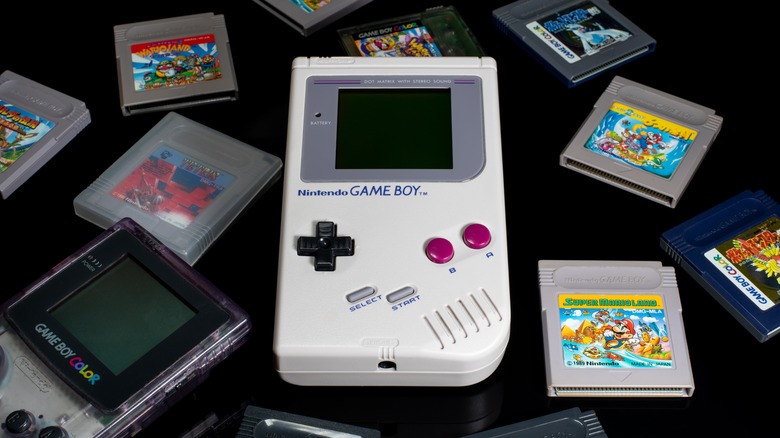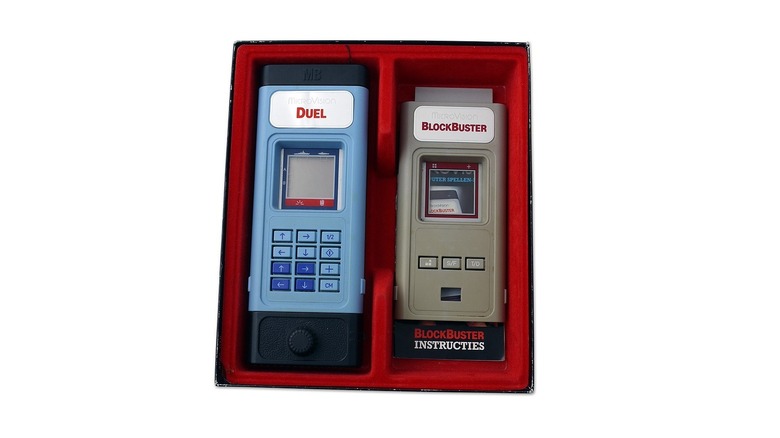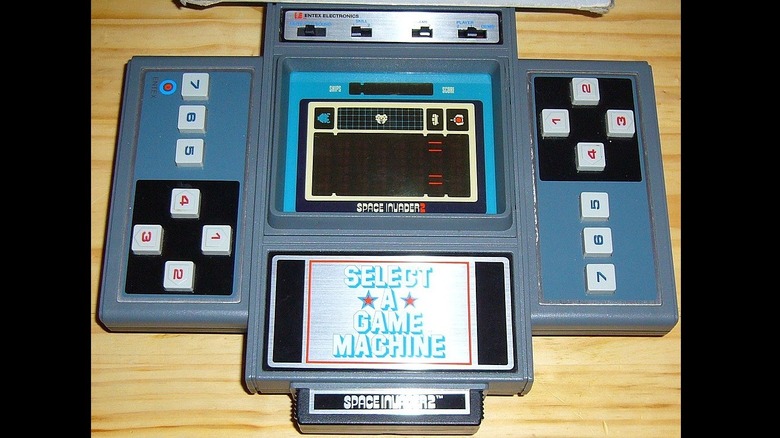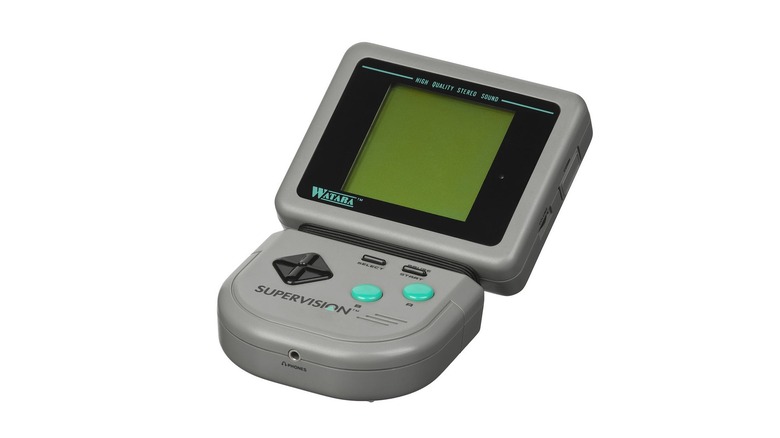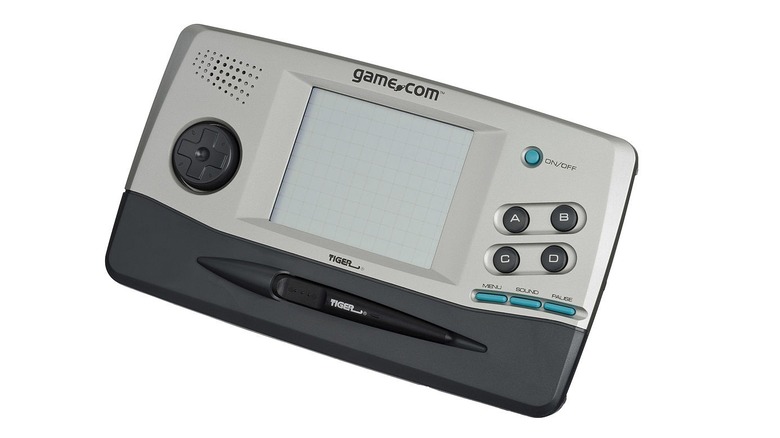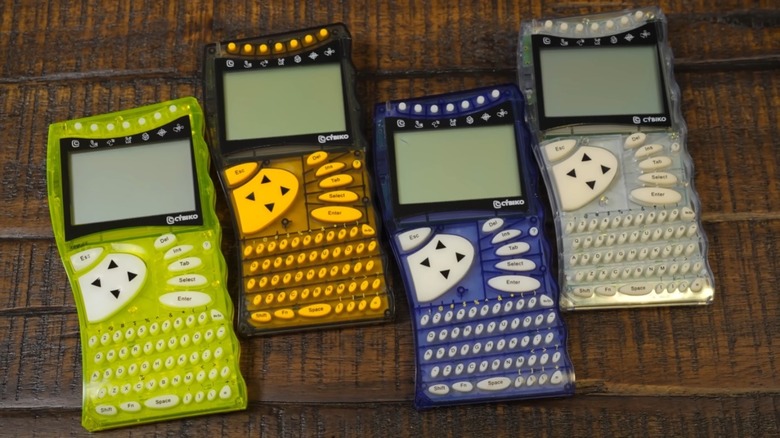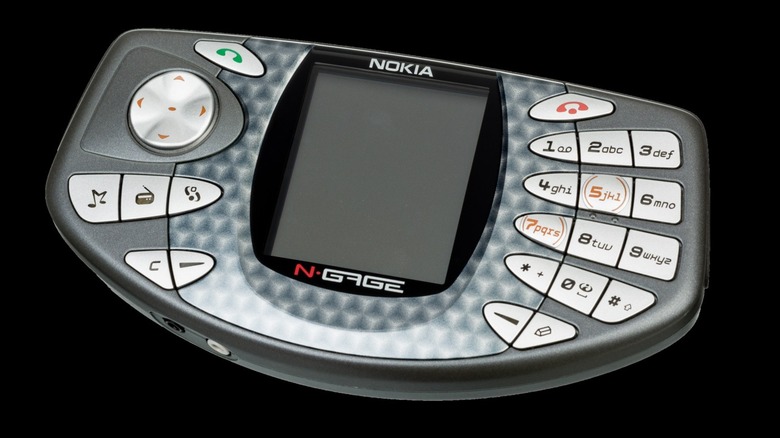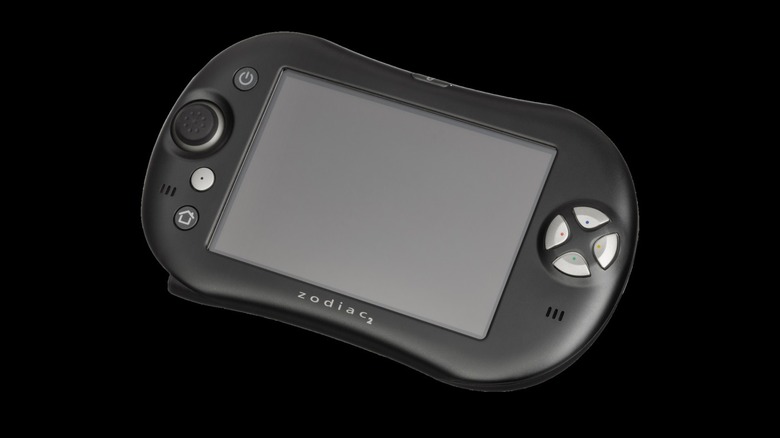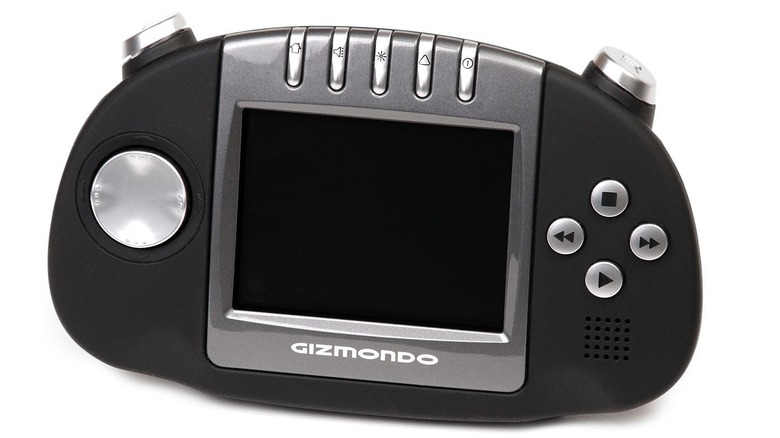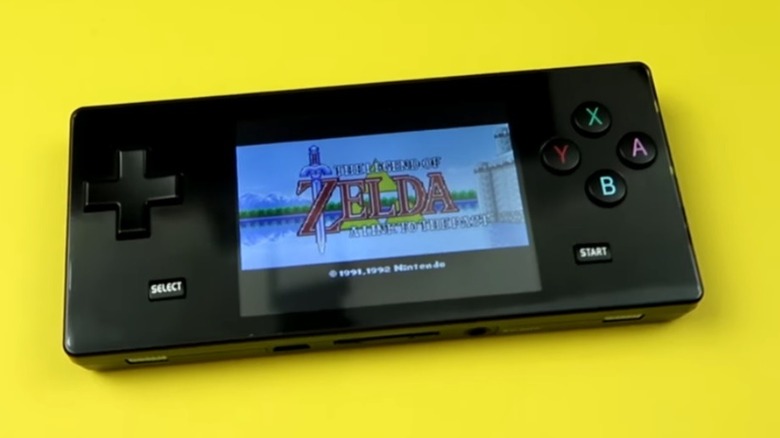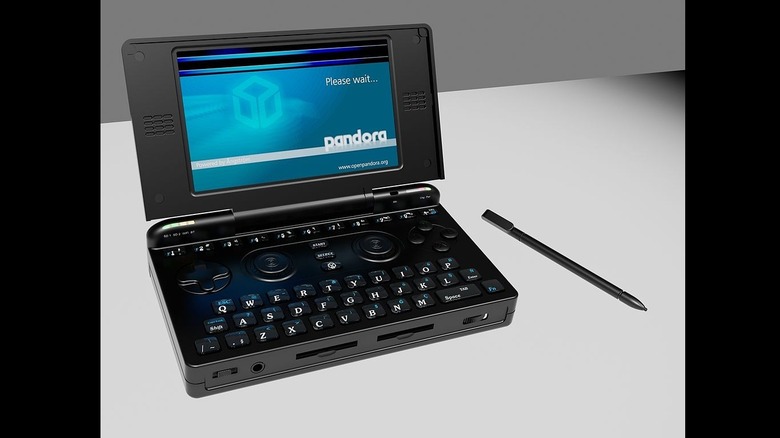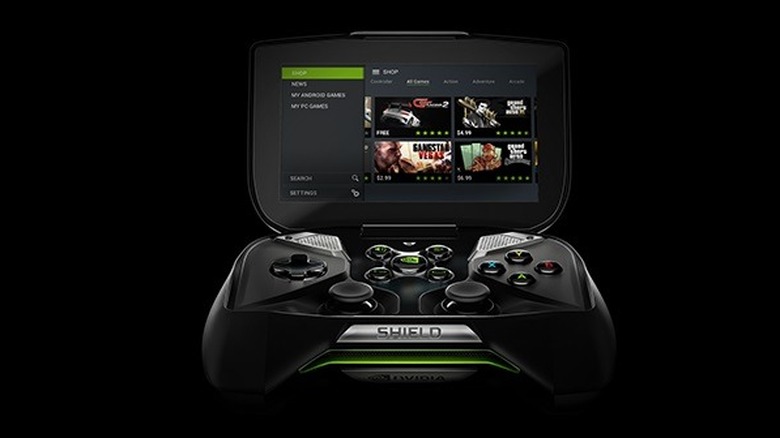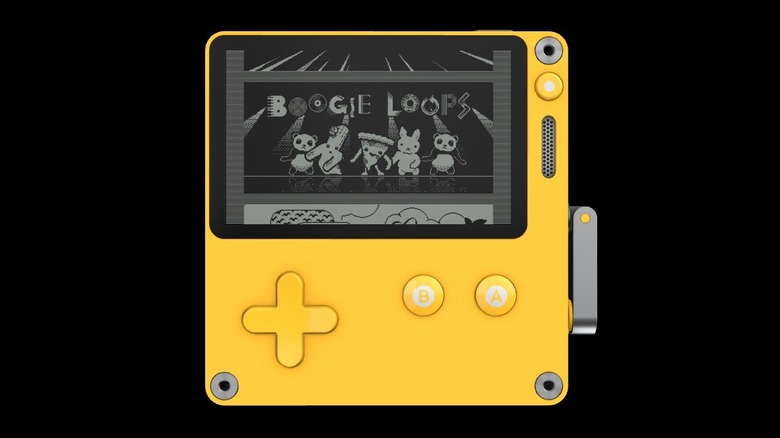The Most Bizarre Gaming Handhelds Of All Time
If you were a kid in the '90s, odds are good that you either owned a Game Boy or wished that you did. It was undeniably the toy du jour among video game fans for years and its success ushered in the age of the handheld gaming console, which is still going strong today.
Nintendo carved an enduring space for themselves in the handheld market — the Game Boy was the best-selling handheld of all time for twenty-one years, from its release in 1989 until 2010 when it was dethroned by the Nintendo DS (via Destructoid) — but others haven't been so lucky. Scores of handheld gaming devices have been manufactured and released over the last several decades, many of which predate the release of the Game Boy, most of which you've probably never heard of.
Along the way, some game companies wandered off the beaten path and created some handheld gaming machines which are as cool as they are weird.
Microvision
Before the well-remembered console war between Nintendo and Sega, and the ongoing battle for supremacy between PlayStation and Xbox, toy makers Mattel and Milton Bradley battled for control of the handheld market. By the late 1970s, handheld video games were emerging as a new kind of toy, driven in large part by the popularity of dedicated handheld games like Mattel's "Football," released in 1977. Consequently, Milton Bradley saw the potential dollar signs and set out to capture their own piece of the handheld gaming pie by one-upping Mattel.
Taking inspiration from home consoles like the Atari 2600, Milton Bradley envisioned a handheld capable of playing more than just one game (via All Game). Despite the popularity of "Football", it came on a dedicated device incapable of playing anything else. In 1979, Milton Bradley's handheld gaming device hit store shelves. Dubbed the Microvision, it is generally considered to have been the very first true handheld video game device (via Video Game Critic).
The Microvision achieved its multigame capabilities by serving as little more than a central hub. The real innovation behind how the Microvision worked was the game cartridge. Each cartridge is attached to the Microvision as a faceplate. The cartridge included a small plastic window for the two-inch display screen as well as the buttons you'd need to play the game. It came stock with "Block Breaker" and consumers could purchase additional cartridges to fill out their collection.
[Featured image by Studio Alijn via Wikimedia Commons | Cropped and scaled | CC0]
Entex Select-A-Game
Two years after the Microvision hit store shelves, Entex got in on the action with their first handheld, the Select-A-Game. It worked on a similar principle as the Microvision, relying on a central hub housing a pixelated display screen, with the rest of the hardware in the game itself.
Upon opening a game box, consumers would find a game cartridge similar in size and shape to those used for the Game Boy Advance, as well as a corresponding overlay to augment the display with a game-specific layout (via Internet Archive). Six games are confirmed to have been released, half of which are sports games, nearly all of which were direct rip-offs of existing properties like "Pac-Man." At the time, Namco had given Coleco the handheld license for the title and Entex ultimately stopped selling their version after a settlement with Coleco (via Handheld Museum).
The thing that earns the Select-A-Game its place in handheld history, however, is its unique button layout. Despite being a handheld, the Select-A-Game kept multiplayer functionality in mind in its design. The device had two sets of controls, one on each side of the screen, allowing two players to enjoy a game at the same time.
[Featured image by Jarkof01 via Wikimedia Commons | Cropped and scaled | Public domain]
Watara Supervision
In the decade after the release of the Select-A-Game, handheld gaming really took off. Nintendo released its definitive Game Boy handheld console and took the world by storm. If competitors had any hope of wrestling away even a small piece of the market from the behemoth that was Nintendo, they were going to have to try something new.
Today, the Nintendo Switch allows for seamless gameplay, straddling the line between handheld and home console, but in the early '90s, that wasn't possible. You had your home console and your handheld and never the twain shall meet. Then, in 1992, the Supervision attempted to solve that problem (via Obsolete Worlds).
The Supervision borrowed from the Game Boy at least a little in overall aesthetic but employed an adjustable screen, allowing players to customize their viewing experience. It also had a couple of small legs which allowed you to prop the device up during play. Most exciting of all was the TV-Link Base. Connecting the device to the base transferred the gameplay from your Supervision to your TV, a process familiar to Switch owners. Unfortunately, the overall gameplay experience wasn't great, and the Supervision suffered from leaning on style over substance.
[Featured image by Evan-Amos via Wikimedia Commons | Cropped and scaled | Public domain]
Game.com
In the annals of video game history, Tiger Electronics is known for two things. They made a lot of games and most of them weren't very good. They were good at getting through road trips but not much else. The Game.com handheld console was supposed to fix that and make Tiger a legitimate player in the handheld space. That obviously didn't happen, but the Game.com is an interesting gadget, nonetheless.
Released in 1997, the Game.com was certainly a gaming device but it was so much more. When you turned it on, you were greeted with six icons. The first icon let you play a game cartridge, another let you see high scores, and another was Solitaire, which came standard on the device. The rest took you to a phone book, calendar, and calculator. The Game.com device glimpsed the digital future coming down the pipe and attempted to position itself favorably. In addition to its offline features, the device could connect to the internet with a modem connection (via Siloconera). It also had a touch screen and stylus, something which wouldn't hit the mainstream handheld gaming devices until the Nintendo DS.
Despite all of its bells and whistles, not to mention an impressive games lineup including "Mortal Kombat" and "Resident Evil 2" the device had severe graphical limitations and a slow refresh rate (via Video Game Critic) which was a detriment to gameplay. Ultimately, only about 300,000 units were sold and the Game.com was largely forgotten.
[Featured image by Evan-Amos via Wikimedia Commons | Cropped and scaled | Public domain]
Cybiko
Released in 2000, the Russian-manufactured Cybiko tried to be a modern smartphone before we really knew what that was. According to ABC News, the Cybiko attempted to fill the gap between the Palm devices popular among professionals, and the Game Boy, which was seen as a toy for children. The Cybiko targeted the market in between, the teenagers who still like games but have other interests.
The Cybiko certainly played games, but it had a whole host of other functions, most of which relied on connecting to a computer or linking up with other Cybiko users. Your device could connect to a computer and take advantage of an internet connection to download free software from the manufacturer's website. You could also load music and use your Cybiko as an MP3 player, but things got really interesting out in the real world.
If you found yourself within 300 feet of another Cybiko, you could exchange messages using the built-in two-way radio or wireless text messaging system (via Science Museum Group). The Cybiko also took Napster's peer-to-peer music-sharing philosophy into the real world, allowing users to share music with other Cybiko owners within range. It also served as a real-world online dating device, alerting users if someone matching their specified romantic preferences was within 300 feet. You couldn't swipe right, but you could chat them up using the previously mentioned communication abilities. If you hit it off, you could sit down, link up, and play games together.
N-Gage
In the late '90s and early 2000s Nokia practically owned the mobile phone market. As the technology advanced, they made a move to expand their empire into gaming while still maintaining a stranglehold on cell phones. The result was the N-Gage, marketed as the first truly hybrid cell phone and gaming handheld.
Sometimes, when you combine two things both of them are enhanced, like chocolate and peanut butter. Other times, both things are diminished. That was the case with the N-Gage, released in 2003. The gameplay involved using cell phone-style buttons. Those buttons are fine for keying in a phone number but aren't optimized for navigating sprites around digital landscapes. There were also issues with the call experience, making it difficult to hear the other party. In its attempts to be both a good phone and a good handheld, the N-Gage failed to achieve either. Worse, inserting games was hugely inconvenient. Swapping a game card required pulling the back off your phone and removing the battery. Even a multimillion-dollar marketing campaign wasn't enough to overcome the N-Gage's shortcomings.
According to Cnet, Nokia fixed many of the device's problems in the second version, but they needed a knockout exclusive title to really capture market interest, something that never really materialized. Shortly thereafter, Sony announced the PlayStation Portable and any hope for the N-Gage fizzled away.
[Featured image by Evan-Amos via Wikimedia Commons | Cropped and scaled | CC0]
Tapwave Zodiac
Nokia wasn't the only company trying to knock Nintendo off its pedestal in 2003. The Zodiac, from Tapwave, was hailed by some as the next big thing in handheld gaming. At release, some reviewers considered it a legitimate threat to the reigning titans of gaming, including the then-upcoming PSP (via The Gadgeteer).
It featured a 3.8-inch color display, 128 MB of RAM, and 2 built-in SD card slots, and that was just for gaming. The Zodiac also doubled as a Palm PDA. As we've already seen, attempting to make a handheld more than a handheld is often a surefire path to disaster, but the Zodiac seemed like it might overcome the odds.
Tapwave gathered an impressive list of titles, including "Doom II" and "Tony Hawk's Pro Skater 4" (via Retro Games Review) and you could use it as an MP3 player when you weren't fighting demons or kickflipping off an escalator.
Unfortunately, all of the goodwill and hope for the Zodiac came to little more than nothing. It didn't oust the Game Boy or the PSP and has all but been erased from gaming history and collective memory. But it wasn't for lack of trying.
[Featured image by Evan-Amos via Wikimedia Commons | Cropped and scaled | CC0]
Gizmondo
Released in 2005, The Gizmondo attempted to succeed where so many other handhelds had failed, by producing something more than a gaming device. The device was produced by Swedish company Tiger Telematics — not the same as Tiger Electronics — and pulled quadruple duty as a handheld, PDA, GPS, and digital camera (via Inverse).
It had a promising start, including a buffet of early 2000s celebrities attending its launch, including Busta Rhymes and Sting. Despite its ambitions and the fanfare surrounding its launch, the Gizmondo was destined for failure for totally unexpected reasons. The device was the brainchild of Stefan Eriksson, a former car thief and arms dealer turned toy manufacturer. It turns out Eriksson and other high-ups at the company had connections to the Swedish mafia. Shortly thereafter, the company filed for bankruptcy with hundreds of millions of dollars in debt. Then Eriksson wrecked a car worth almost a million dollars and ended up in jail.
The company later emerged with a teaser for a new and improved Gizmondo, planned for release in 2008 but those dreams crashed almost as hard as Eriksson's Ferrari and career prospects.
Dingoo A320
Released in 2009, the Dingoo marries both modern technology and a love for retro games. Instead of offering a selection of licensed physical games, the Dingoo serves as a portable emulator capable of playing everything from the NES and Game Boy to the Sega Genesis. At launch, there was an obvious focus on older systems, but community efforts resulted in additional emulators, including one for playing PlayStation games.
Like some of its predecessors, the Dingoo was also capable of playing music and video, allowing consumers to use it as a wider entertainment device in addition to playing games. The only major complaint about the Dingoo is the variable game quality. Because it's operating with emulators and ROMs, some games weren't quite authentic adaptations of the original, and more recent games tended to experience problems (via Gadget Review).
The Dingoo was a serviceable handheld if you're a fan of retro games and the included cables allow you to link up with your television, to take your gameplay from the street to the couch effortlessly. Those cables, however, are painfully short, leaving you to buy a longer cable or play with your nose against the screen.
Pandora
The Pandora was an objectively cool device that might have been widely adopted in another universe. In our own reality, however, it suffered from a delayed launch which probably caused it to miss the boat.
Before Kickstarter became the independent funding platform of choice, the folks behind Pandora crowdfunded their device from among a community of dedicated handheld gaming fans (via SemiAccurate). The device itself looked an awful lot like a Nintendo 3DS, with a QWERTY keyboard where the touchscreen should be. Users could play games by way of emulation, playing virtual systems from the Commodore 64 through the Nintendo 64 (via Pandora). They could also watch movies, listen to music, surf the web, and use the Office suite of software.
Had it launched on time, things might have gone differently but it didn't ship until 2012, roughly four years after it was announced. That obviously eroded goodwill and interest in the product. It's hard to stay excited for a year about something you already paid for, and you can't generate word of mouth when there's nothing to talk about. By the time the Pandora hit consumers, their window of opportunity was closed.
[Featured image by Michael Mrozek via Wikimedia Commons | Cropped and scaled | Public domain]
Nvidia Shield Portable
Released in 2012, Nvidia's Shield Portable hearkens back to the Supervision, with its flip-up display. The Shield's display is also adjustable, allowing it to fully close or swing open to your preferred viewing angle. It discards the conventional clamshell design of other handhelds in favor of a technological chimera. The Shield Portable looks like a small tablet glued to the top of an Xbox controller. When not in use, the screen folds down into an indentation in the controller, leaving it looking a lot like a George Foreman grill filled with processors instead of paninis. It's a little weird to look at but it packs a big punch.
For the first time, gamers could take the experience and power of a gaming PC with them on the go, with what Nvidia called the most powerful mobile gaming device to date. Much like the gaming PCs it aimed to emulate, the Shield Portable promised a compelling gaming experience alongside a host of other functions.
With an internet connection, consumers could also watch video content from streaming services and listen to music. The Shield Portable is as impressive as it is weird looking. Which is to say, very.
Playdate
The Playdate is a late addition to the handheld gaming pantheon, having launched in April of 2022, and attempts to reimagine the way we interact with handheld gaming devices. At first glance, you could mistake it for a Game Boy Advance SP but on closer inspection, you'd realize there's something different about this little machine. It has the usual buttons, but it also has a little hand crank attached to the side. You'll use that crank to play some of the games.
Speaking of games, you won't find the latest Mario game on the Playdate and the games you will find, you can't buy at your local brick-and-mortar. Instead of heading to the mall or an online play store to pick up games, new independent games are delivered to your Playdate intermittently, via Wi-Fi. The designers relate their games lineup to a season of television, with new games coming out twice every week over a twelve-week period (via Playdate).
Once you get through the initial offerings, Playdate promises more new games in the future. In the meantime, you can also make your own games using the free software provided by the manufacturer. When you're not playing, your Playdate can slide into a stereo dock that charges the device, plays audio, and has a handy pen holder just for kicks.
